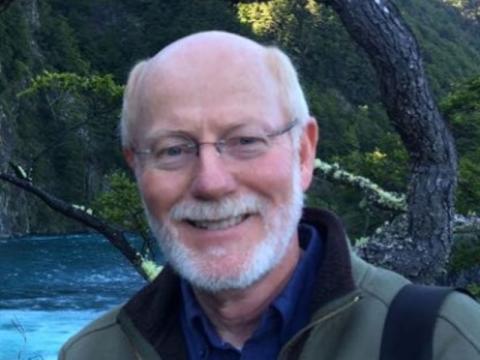
Office
5059 Percival Stern Building
Education & Affiliations
Biography
Areas of current interest:
Light Harvesting
Chemists can play a significant role in the search for new sources of renewable energy to help meet future world energy needs. Of all the prospective renewable energy sources, solar offers the greatest potential return (as much as ten times the world energy needs expected at the end of this century). One area of solar energy related research for chemists is the study of photochemical reactions of molecules that absorb visible light.
Our research includes considerable organic and inorganic synthesis. Our recent efforts have focused on preparing clusters of visible light absorbing chromophores that may be used to "harvest" light. Such light harvesting arrays can be used to channel energy into electrochemical cells designed to convert light to electrical energy (photoelectrochemical cells). The types of chromophores we have examined include porphyrins , phthalocyanines and a variety of transition metal complexes. Through a combination of synthetic and laser spectroscopic investigations, our group studies the factors that influence the reactivity and stability of these classes of visible chromophores.
Photocatalysts
Another area of research in our group, related to solar energy conversion to chemical energy, is the study of what is referred to as one photon-two electron reactions. Using transition metal complexes that undergo two electron redox processes (i.e. Pt(II) to Pt(IV)), we are attempting to develop photochemical systems that can undergo redox cycling to serve as photocatalysts for the production of useful reagents.
Materials
Many of the N-heterocyclic ligands we prepare for light harvesting systems are strongly luminescent and are related to materials used for the development of organic light emitting diodes (OLEDs). The ligands have emission that can be tuned to span the visible spectrum.
We are currently exploring the luminescence behavior of these complexes in solution and on surfaces. By gaining control of surface morphology via various surface deposition techniques, we hope to prepare highly luminescent surface bound chromophores that can be used in OLEDs or sensing applications. We study surface marpology using scanning electron microscopy (SEM) and (TEM).
Discipline
Photochemistry, Materials, Transition Metal Chemistry
Selected Publications
2023
Martinez, K, Koehne, SM, Benson, K, Paul, JJ, Schmehl, RH Bimolecular Excited-State Proton-Coupled Electron Transfer within Encounter Complexes. J. Am. Chem. Soc., 2023, 145, 8, 4462-4472. DOI: 10.1021/jacs.2c10165.
2019
Martinez, Kristina; Stash, Jacqueline; Benson, Kaitlyn; Paul, Jared; Schmehl, Russell "Direct Observation Of Sequential Electron And Proton Transfer In Excited State ETPT Reactions" Journal of Physical Chemistry C, 2019, in press, DOI: 10.1021/acs.jpcc.8b09268.
Liyanage, Nalaka P.; Yang, Weiwei ; Guertin, Stephen; Roy, Sayontani Sinha; Carpenter, Casey A.; Adams, Rebecca E.; Schmehl, Russell H.; Delcamp, Jared H.; Jurss, Jonah W. “Photochemical CO2 Reduction with Mononuclear and Dinuclear Rhenium Catalysts Bearing a Pendant Anthracene Chromophore” Chemical Communications, 2019, in press. , DOI: 10.1039/c8cc09155b.
2018
Qu, Fengrui; Martinez, Kristina; Arcidiacono, Ashley M.; Park, Seungjo; Zeller, Matthias; Schmehl, Russell H.; Paul, Jared J.; Kim, Yonghyun; Papish, Elizabeth T. “Sterically demanding methoxy and methyl groups in ruthenium complexes lead to enhanced quantum yields for blue light triggered photodissociation” Dalton Transactions, 2018, 44, pp . DOI: 10.1039/c8dt03295e.
Huckaba, Aron J, Shirley, Hunter; Lamb, Robert W. ; Guertin, Steve ; Autry, Shane; Cheema, Hammad; Talukdar, Kallol; Jones, Tanya; Jurss, Jonah W. ; Dass, Amala; Hammer, Nathan I.; Schmehl, Russell H.; Webster, Charles Edwin; Delcamp, Jared H. “A Mononuclear Tungsten Catalyst for Hydrogen Production” ACS Catalysis, 2018, 8, 4838, 4847. DOI: 10.1021/acscatal.7b04242.
Adams, Rebecca E.; Grusenmeyer, Tod A.; Griffith, Audrey L.; Schmehl, Russell H. “Transition Metal Hydride Complexes as Mechanistic Models for Proton Reduction Catalysis” Coordination Chemistry Reviews, 2018, 362, 44-53. DOI: 10.1016/j.ccr.2018.02.014.
2017
Peddapuram, A.; Cheema, H.; Adams, R. E.; Schmehl, R. H.; Delcamp, J. H., A Stable Panchromatic Green Dual Acceptor, Dual Donor Organic Dye for Dye-Sensitized Solar Cells. Journal of Physical Chemistry C 2017, 121 (16), 8770-8780.
Wang, J.; Waters, J. L.; Kung, P.; Kim, S. M.; Kelly, J. T.; McNamara, L. E.; Hammer, N. I.; Pemberton, B. C.; Schmehl, R. H.; Gupta, A.; Pan, S., A Facile Electrochemical Reduction Method for Improving Photocatalytic Performance of alpha-Fe2O3 Photoanode for Solar Water Splitting. Acs Applied Materials & Interfaces 2017, 9 (1), 381-390.
White, J. K.; Schmehl, R. H.; Turro, C., An overview of photosubstitution reactions of Ru(II) imine complexes and their application in photobiology and photodynamic therapy. Inorganica Chimica Acta 2017, 454, 7-20.
2016
Adams, R. E.; Schmehl, R. H., Micellar Effects on Photoinduced Electron Transfer in Aqueous Solutions Revisited: Dramatic Enhancement of Cage Escape Yields in Surfactant Ru(II) Diimine Complex/ Ru(NH3)(6) (2+) Systems. Langmuir 2016, 32 (34), 8598-8607.
Kaneza, N.; Zhang, J. T.; Liu, H. Y.; Archana, P. S.; Shan, Z. C.; Vasiliu, M.; Polansky, S. H.; Dixon, D. A.; Adams, R. E.; Schmehl, R. H.; Gupta, A.; Pan, S. L., Electrochemical and Spectroscopic Properties of Boron Dipyrromethene-Thiophene-Triphenylamine-Based Dyes for Dye-Sensitized Solar Cells. Journal of Physical Chemistry C 2016, 120 (17), 9068-9080.
Yue, Y. K.; Grusenmeyer, T.; Ma, Z.; Zhang, P.; Schmehl, R. H.; Beratan, D. N.; Rubtsov, I. V., Electron transfer rate modulation in a compact Re(I) donor-acceptor complex (vol 44, pg 8609, 2015). Dalton Transactions 2016, 45 (2), 842-842.
